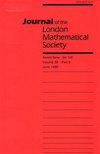加权斯坦豪斯随机乘法函数的几乎确定边界
IF 1
2区 数学
Q1 MATHEMATICS
Journal of the London Mathematical Society-Second Series
Pub Date : 2024-08-22
DOI:10.1112/jlms.12979
引用次数: 0
摘要
我们得到了加权和 ∑ n ⩽ t f ( n ) n $\sum _{n \leqslant t} 的几乎确定的边界。\其中 f ( n ) $f(n)$ 是一个斯坦豪斯随机乘法函数。具体来说,我们通过迭代对数的指数化法则得到了预测的边界,给出了尖锐的上下限。本文章由计算机程序翻译,如有差异,请以英文原文为准。
Almost sure bounds for a weighted Steinhaus random multiplicative function
We obtain almost sure bounds for the weighted sum , where is a Steinhaus random multiplicative function. Specifically, we obtain the bounds predicted by exponentiating the law of the iterated logarithm, giving sharp upper and lower bounds.
求助全文
通过发布文献求助,成功后即可免费获取论文全文。
去求助
来源期刊
CiteScore
1.90
自引率
0.00%
发文量
186
审稿时长
6-12 weeks
期刊介绍:
The Journal of the London Mathematical Society has been publishing leading research in a broad range of mathematical subject areas since 1926. The Journal welcomes papers on subjects of general interest that represent a significant advance in mathematical knowledge, as well as submissions that are deemed to stimulate new interest and research activity.

 求助内容:
求助内容: 应助结果提醒方式:
应助结果提醒方式:


